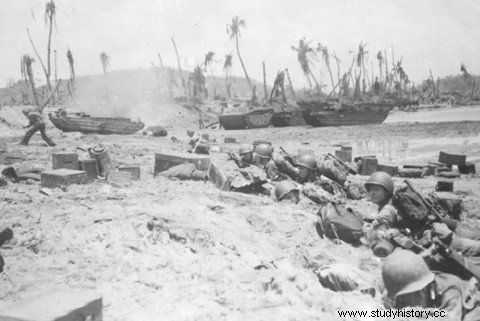The Japanese garrison, obeying orders, had not fired during the landing; Only 5 amphibious tractors were put out of action among the first waves. Taking advantage of the assault being checked by the terrace and the creeping barrage moving away from the Marines. the Japanese closest to the beach began to recover the abandoned weapons and put them in position.
The ash from the beach cushioned the impact of the bullets but not that of the shells. "Nowhere... have I seen bodies so torn to pieces," declared a war correspondent. It soon became apparent that staying on the beach was tantamount to suicide in some way, but walking away from it meant exposing yourself to fire from a fully developed device.
At that moment - and only then -was the outcome of the battle
uncertain. If the Japanese had then launched a counter-offensive, perhaps they would have routed the Marines. But the experience of Tarawa, Roi-Namur, Saipan and Guam had taught the Japanese that violent counterattacks only exposed their defense to overwhelming American fire superiority.

Kuribayashi had been instructed to delay surrendering Iwo Jima to the enemy as long as possible, and his men had been ordered to stand strictly on the defensive. A large number of guns only fired sporadically to save ammunition. The initiative was always with the Marines; Admittedly mistreated by the Japanese artillery, the Marines had just landed successfully.
Slowly, very slowly, they sank inside the island, in small disorderly groups rather than as a united force. Every hole, every shelter meant a life-and-death struggle. Each enemy position was protected by many others:the Japanese disappeared into a gut to reappear elsewhere, often behind the Marines' backs.
The Marines advanced, however, strafing enemy positions or clearing them with grenades and flamethrowers. Tanks accompanied them, blowing up the mines, while bulldozers were busy breaking into defenses and concrete shelters.
But nothing was easy, even with armor. Thus, for example, facing the lines of the 4th Division were 10 reinforced concrete blockhouses, 7 camouflaged artillery positions and 80 concrete shelters. According to the account of a battalion commander, “every time a man showed up, he was sure to sign his death warrant. »
By mid-afternoon, the battalions of 4 regimental combat groups, hitherto kept in reserve, as well as 2 tank battalions had been engaged in the battle to relieve the head units.
By the time night fell on this first and bloody day of battle, the number of Marines landed amounted to 30,000 men, including the men of the reserve regiments who had come to swell the 2 divisions. The left wing, Col. Harry B. Liversedge's 28th Regiment, had managed to cross the line of ridges overlooking the beach to the southwest; but his advance towards the main objective, Mount Suribachi, had been halted.
Not far away, the 27th regiment of Colonel Thomas A. Wornham also had to stop while it tried to seize airfield No. 1. Further on, on the right, the 2 regiments of the 4th Division, the 23rd Marines of Colonel Walter W. Wensinger and the 25th Marines of Colonel John R. Lanigan, were greeted by a hellish fire from the plateau of Moto-yama, while the 25th Regiment, at the right end, suffered heavy losses.
If the Marines had failed to achieve the objectives they had set for the first day, at least they had secured a foothold. Reinforced by the arrival of the reserves, they buried themselves to await the counter-attack. She did not come. Instead, the Japanese continued to concentrate very precise artillery and mortar fire on the beaches, causing extensive damage.
What the American soldiers feared most were the 60 and 250 kilo bombs; their shrill whistle threw the men to the ground, made them cower:“A nightmare in hell. »
On the morning of the second day, after a naval bombardment, the Marines resumed their journey. But their progress was even slower than the day before. Liversedge's 28th Regiment made repeated attacks on the approaches to Mount Suribachi with support from nearby artillery, half-tracks and destroyers, but advanced only 200 yards that day. /P>
To the north, the 4th Division captured Airfield No. 1 and swung to the right to present itself in front of the slope which constituted the first main fortified line of Kuribayashi. Here too the Americans soon had to slow down and then stop. On the other hand, the 28th regiment, again supported by naval and air bombardment, almost reached the foot of the Suribachi.
